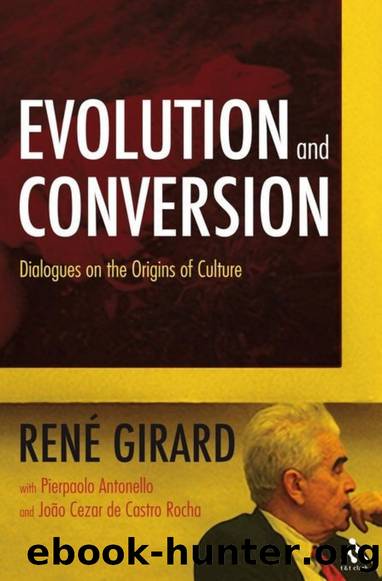Evolution and Conversion: Dialogues on the Origins of Culture by Rene Girard

Author:Rene Girard [Girard, Rene]
Language: eng
Format: epub
ISBN: 9780567032522
Google: SvjTAwAAQBAJ
Amazon: 0567032523
Barnesnoble: 0567032523
Goodreads: 2930212
Publisher: Continuum International Publishing
Published: 2011-04-15T05:00:00+00:00
This text contains everything and tells everything, even the ultimate divinization of the victim, and the victimary and ritualistic nature of monarchy, but at that time I did not realize it. The discovery of the victimary mechanism was really connected with the reading of Oedipus and above all with The Bacchae. At that time I compared the tragedies with myths and rituals. Rituals were even more important than myths because they are more transparent. They quite eloquently stage what I call the mimetic crisis, followed by its resolution through collective violence. From the moment we understand that we are dealing with a mimetic transfer against the victim, we understand why violence stops, and also why all human cultures ritually reproduce this sequence. The element that was decisive in the development of my ideas was the repetition of the entire process in the ritual re-enactment. Why is it repeated again and again? It needs to reproduce the initial effect of the mechanism, the reconciliation against the victim, to reinforce and re-establish the communal harmony disrupted by mimetic rivalries.
You have always made clear that classical ethnology (1850â1950) was fundamental to your theory. Considering the scapegoat mechanism, how important were Frazerâs descriptions of rituals involving scapegoats?2
Some critics have said that Frazer had already recognized the scapegoat mechanism in its mimetic sense. This is wrong, because there is no scapegoat mechanism in Frazer. For him, the scapegoat is mainly a materialized metaphor. The primitives believed they could discharge their sins onto the backs of substitute human or animal victims.3 Frazer did not realize that this metaphor of sin as a burden is quite elaborate and essentially âmodernâ. This metaphor very likely comes from the Protestant sermons that he had heard in his youth.
Nevertheless, regarding the interplay of ritual and prohibition that follows the victim mechanism, some of Frazerâs descriptions were really inspirational to me, and they opened my eyes. We find the actual effects of the scapegoat mechanism. This is where he is at his best, because he understands that all the phenomena he describes are related to one another, even though he does not have a realistic conception of the scapegoat mechanism. That is, he does not see, as I do, that the scapegoat is more than a metaphor, a way of expressing a circumstance that has actually taken place at the threshold of human culture.
In any case, Frazer could not deepen his insight, due both to his prejudice against religion and his contempt for the cultures he studied. He thought the people he studied were fools, and many scholars interpret me as if I concurred with this view. They do not see that primitive religion, in an archaic context, is an incredibly constraining, and at the same time rational, process. The only way one can rationally account for the reconciliation of a society brought by the founding murder is if one firmly believes that the scapegoat is both culprit and reconciler. It can only happen if one attributes some sort of religious transcendence to the scapegoat.
Download
This site does not store any files on its server. We only index and link to content provided by other sites. Please contact the content providers to delete copyright contents if any and email us, we'll remove relevant links or contents immediately.
The remains of the day by Kazuo Ishiguro(7601)
Tools of Titans by Timothy Ferriss(7003)
The Black Swan by Nassim Nicholas Taleb(6237)
Giovanni's Room by James Baldwin(5938)
Inner Engineering: A Yogi's Guide to Joy by Sadhguru(5931)
The Way of Zen by Alan W. Watts(5829)
The Six Wives Of Henry VIII (WOMEN IN HISTORY) by Fraser Antonia(4815)
The Power of Now: A Guide to Spiritual Enlightenment by Eckhart Tolle(4795)
Astrophysics for People in a Hurry by Neil DeGrasse Tyson(4641)
Asking the Right Questions: A Guide to Critical Thinking by M. Neil Browne & Stuart M. Keeley(4627)
12 Rules for Life by Jordan B. Peterson(3780)
The Ethical Slut by Janet W. Hardy(3534)
Skin in the Game by Nassim Nicholas Taleb(3503)
Housekeeping by Marilynne Robinson(3443)
The Art of Happiness by The Dalai Lama(3409)
Double Down (Diary of a Wimpy Kid Book 11) by Jeff Kinney(3302)
Skin in the Game: Hidden Asymmetries in Daily Life by Nassim Nicholas Taleb(3290)
Walking by Henry David Thoreau(3250)
12 Rules for Life: An Antidote to Chaos by Jordan B. Peterson(3215)
